How Does a Funny Car Keep Tire Traction
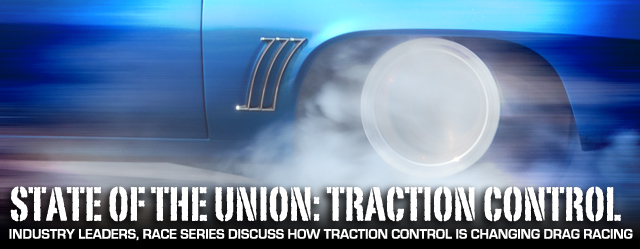
As recently as a decade ago, traction control was i of those topics, like nitrous oxide in Pro Stock or the infamous Matty Box, that you simply didn't dare talk about. A taboo field of study if there ever was one, the engineering science that had long been a part of circle track and route racing was largely prohibited in all of the major drag racing series and sanctions of the one sport where traction was nigh paramount.
Gradually, respected manufacturers began working to legitimize the engineering that had been such a hush-hush discipline in decades by, making it possible not only to equip a race automobile with information technology in a professional person and well-engineered package, but do it in an affordable fashion. The trouble yet, at least in terms of heads-upward racing, was that would-be customers had nowhere to run it.
In the early on to mid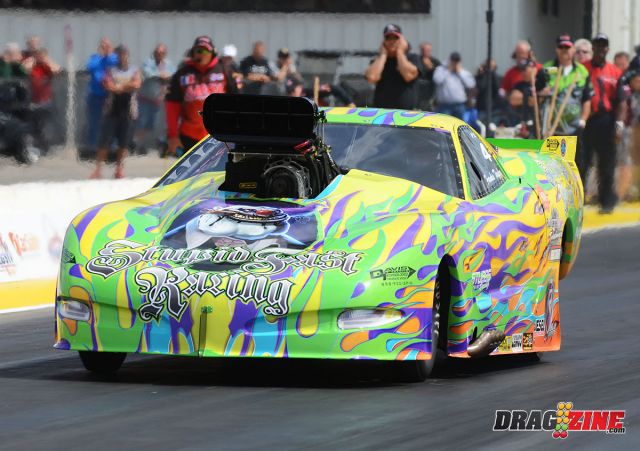 -2000's, the world of outlaw doorslammer racing took to the technology and spread it like wildfire, thrusting the previously forbidden topic into the limelight. Suddenly, a system that was previously the middle of conspiracy theory churr during a rain delay was something that racers would openly promote and talk well-nigh. And it passed tech with flying colors.
-2000's, the world of outlaw doorslammer racing took to the technology and spread it like wildfire, thrusting the previously forbidden topic into the limelight. Suddenly, a system that was previously the middle of conspiracy theory churr during a rain delay was something that racers would openly promote and talk well-nigh. And it passed tech with flying colors.
Although traction control is all the same barred and heavily policed in the NHRA and countless other racing serial, it's become a mostly accepted office of the game. From Superlative Fuel to Pro Farthermost, between and beneath, teams are utilizing the data that information technology provides to meliorate their performance and deliver improve, closer racing.
In this circular table Q&A session, nosotros'll have a expect at the current state of the traction command fence from the perspective of the racing serial that both prohibit and permit it and the manufacturers that campaign heavily in favor of information technology. Among those in our panel are:
- Promedia Manager of Events Trey Capps
- 10-DRL Technical Managing director Chris Bell
- Joe Pando with MSD Performance
- Davis Technologies President Shannon Davis
Traction Control At A Glance
It's hard to pinpoint when and where traction command entered the sport of drag racing, and with so many forms of RPM, timing, nitrous, and heave controls at a racers' fingertips today, the lines betwixt what is legal and what is illegal is undeniably blurry. At the center of a legitimate traction control system is a device capable of capturing and relaying data to the engine direction system, pulled from sensors on the driveshaft, the transmission, or the rear end housing, that chop-chop and efficiently result in adjustments to the timing or the engine RPM to right the tire spin. These systems are not but infinitely adjustable, but many modern systems are self-learning, pregnant they're capable of comparing the rate of dispatch of the crank to a calculated threshold value that's adjusted in relation to the average of previous calculated measurements.
Different the rudimentary systems that racers and sneaky electricians hacked together years ago, today's traction command systems are affordable and incredibly meaty, making them nearly undetectable if a racer truly wants to muffle one. Likewise, with data recording such a mutual and attainable element of racing in this twenty-four hour period and age, smart racers can tune their race cars to cope with traction loss in perfectly legal ways, begging the question: what is traction control and what isn't?
Read on as we speak to the aforementioned figures in the sport and the manufacturing manufacture to larn their take on this e'er-popular topic.
DZ: Every bit far as you know, when did traction control first enter the sport? Do you call up there were subconscious, dwelling house-made systems used by racers long before traction control systems were mass-produced?
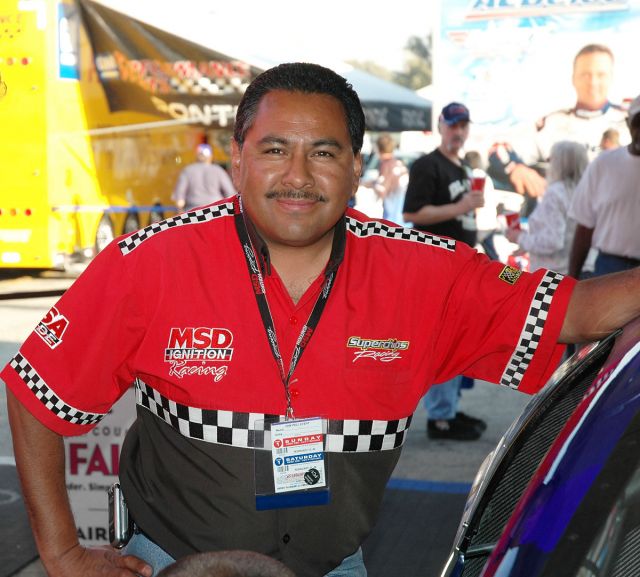
MSD Performance's Technical Back up Manager Joe Pando.
Shannon Davis: We put together our first drag racing pieces in 2002 or 2003, and it was the outset time that nosotros had adapted a circumvolve track system over to drag racing. It was fairly successful, and those older units were amend at saving a run, simply not necessarily making it faster. Equally this technology evolved, all the same, the aim was not just to salve a run and accept a pick-me-upward crutch, just make the car run faster.
I'm sure that in that location were hidden traction control systems prior to that, but I don't know how effective any of them were, because y'all never saw them take off. But it's probable that there were some summit pro teams that were using information technology. There are a lot of smart racers and coiffure chiefs out at that place that could've certainly built something, and then it's likely that teams had a system that worked off of cycle speed sensors or, theoretically, even footing-based lasers.
Traction control is something that'due south hard to do remotely, because in the past, remote communications weren't fast enough and certainly non without having something obvious like a large antenna on the car. With a system similar that in that day and historic period, by the time the lasers could send the proper signal, information technology would've been also tardily.
DZ: The topic of traction control has been very taboo, but practice you think it's becoming more than accepted around the sport?
Joe Pando: I don't think you demand to look any further than the ADRL, which is a major series that's legalized traction control. Its utilize doesn't create a lopsided sport, because if you look at the list of winners, information technology isn't e'er the aforementioned racers. In that location are several teams that are using our traction control and those from other manufacturers, and no one racer is dominating.
Case Data Of A Run Using Davis Traction Control With Nitrous Oxide
Chris Bell: Assuasive it, merely keeping an middle on it, has allowed it to go more acceptable, and other organizations accept begun to have it more because of that. Other series have looked at information technology and seen that information technology does produce a meliorate prove and that information technology's a little safer because they get up and down the race track more than consistently.
It's difficult to say that traction control is bad for the sport when you look at the competitive racing that goes on in the ADRL.
Trey Capps: I don't know that it's more accepted, only it's certainly more than understood and more attainable for racers to acquire.
Shannon Davis: Traction control is definitely more than accustomed in the venues where it's immune, because we make a living at it. Where it's not allowed, I'1000 sure that it creeps into conversations, considering nosotros have several racers that compete in the ADRL and and so go over and run with the NHRA.
It's hard to say that traction control is bad for the sport when you expect at the competitive racing that goes on in the ADRL. – Chris Bell

Overall, I call up people are more accepting of it around the sport. The phrase "time heals all wounds" might describe it best. But I think the sanctioning bodies and the racers are realizing that traction control isn't a process of just writing a cheque, installing a blackness box in the auto, and setting world records. That's only non how it works. The best tuners in the business are however going to stitch front, and that's the same fashion that information technology worked in circumvolve track racing earlier we brought the technology to elevate racing. The traction control never fabricated anyone a hero.
I recollect at that place's just a misunderstanding that a racer tin can claw upwardly traction control, make 10,000 horsepower, and the car is going to magically hook up.
DZ: Why have you opted to let the utilize of traction control, and do yous continue to support that idea today?
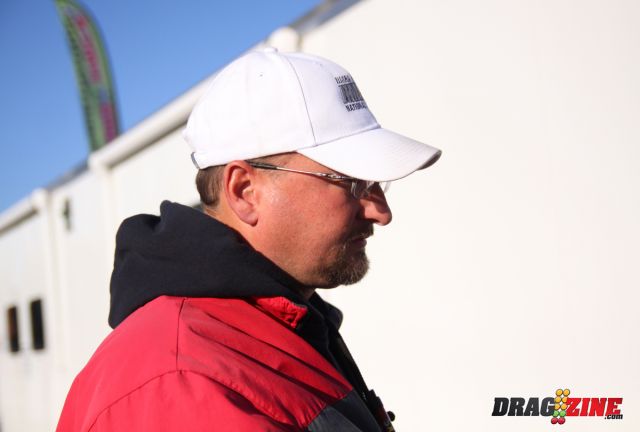
Trey Capps, Result Managing director at Promedia Events for the NMRA, NMCA, and NMCA West Serial.
Bell: We definitely still support the technology in our series, and nosotros haven't seen any detrimental effects from it in our classes. Early, no 1 knew how many cars had it and information technology was tough to keep track of, but we monitor it closely to ensure that no ane gains a performance edge from information technology.
We're not afraid of engineering, we just brand every effort to empathise the technology and make our decisions based on that.
DZ: Exercise yous feel that traction control has allowed the ADRL to boast a better show for the fans? We come across equally good racing in other doorslammer venues, so does information technology really brand that much of a difference?
Davis: In that location are a lot of arguments to this, only information technology really comes downwards to whether you want to run across the cars accident the tires off or if y'all want to meet them make side-by-side passes. Whether a team bolted in a traction control box and learned how to use information technology, or they figured out how to make consistent runs some other way, it's exciting to see a racer similar Frankie Taylor run in the 3.50's. The oversupply is on their anxiety and anybody's excited. Simply, close racing tin can be done with or without it.
Traction Control Comparing Video With Pro Extreme Racer Mike Janis
When Frankie unloads off the trailer, their traction control may engage six or eight times on the beginning laissez passer, and then they have that information and run across where the car needs help. From that, they can make adjustments and on the 2d run it might simply come on iii times. Eventually, they're looking to see where it didn't come on and they may try another caste hither or at that place to see if information technology spins, and generally by the time they get into eliminations, the traction control is only coming on at the shifts. You could ask whether or not it needs information technology, and that's the big question. The only way to know for sure is to run the car with information technology and without it.
Bong: I think that it's allowed teams a little more than data to learn and tune from, and therefore, it's improved their plan. It's allowed them to brand more complete runs.
Information technology really comes down to whether you desire to see the cars blow the tires off or if you want to see them make side-past-side passes. – Shannon Davis

We've made some significant gains in our track prep procedures over the final couple of years, and because of that, traction control has get less of a factor and racers aren't relying on information technology every bit much as they had in the past. If it had never been instituted or if we prohibited it at present, though, I believe that you would see an increase in the number of aborted runs and less side-by-side competition.
DZ: Do you lot think traction control belongs in bracket racing, or does it provide a tangible competitive reward?
Capps: More than anything, information technology's just one more than thing that a racer has to buy. The thought process is that if one racer has it, you have to accept it, and if you lot don't have it, you won't be competitive. It's but 1 more expense to add to what's already a very expensive hobby. A racer still has to hitting the number, but if y'all can tie in traction control with all of the systems that are available to a bracket racer, you're really not driving the motorcar anymore.
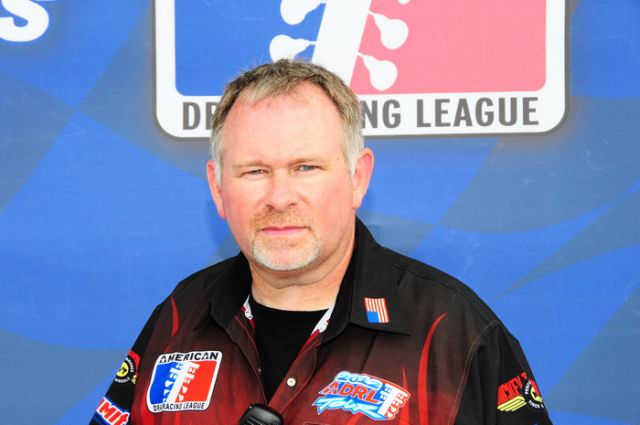
Current X-DRL (and one-time ADRL) Technical Manager Chris Bell.
Pando: As it is right now, in the .90 classes in the NHRA and IHRA, there are often 32 cars or more that are bunched up with only a few thousandths of a second between them, and thus traction control wouldn't create much benefit for those racers. Simply await at what they're doing right at present without information technology. Bracket racers in full general accept their combinations down so well, and the racing is so close, that little would change with the employ of traction control.
Davis: Most bracket racers aren't on the ragged border of what their tires can handle, merely virtually whatever car tends to take some slip on the shift. By minimizing that slippage, yous take a more consistent run. Some racers swear past it, and they run really well with it. That slippage on the shift is just i more variable that we can have out of the equation. Really, the big argument is the cost, but who do you know that always went racing to save money?
DZ: Is traction command an reward for the more experienced race teams, or those getting their feet moisture?
Joe Pando: Traction control is a keen affair to have on bad race tracks. If you look dorsum to the NHRA race in the fall at Charlotte, the rails preparation and the weather changed the racing surface and the Pro Stock racers were entirely opposed to racing on it, but were forced to, and unfortunately, Shane Grayness destroyed a race car. There were a lot of aborted runs prior to and after that, and had at that place been some form of command over the race auto, information technology could've inverse the outcome of that event.
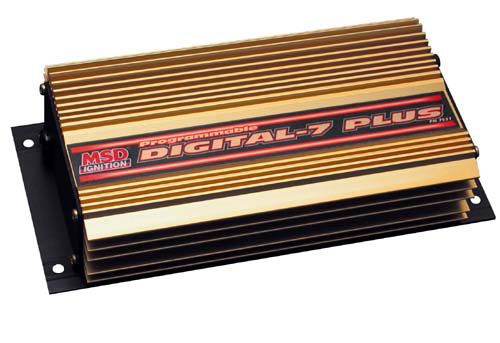
MSD'south 7531 box features what's known equally a"Slew Rate Rev Limiter", which is tunable by the end user to conform RPM should engine exceed a pre-ready acceleration limit, in essence creating a grade of traction control. Because of this capability, the box is outlawed in some venues.
Traction command won't make a fast run any faster, but it will decrease the number of aborted runs. In the end, could traction control accept created a improve show for the fans? We actually don't know the answer to that without trying it.
Davis: It definitely speeds up the learning curve on the beginner or a racer with a new car or combination, because if you go out in that location weekend after weekend and blow the tires off or lose races because you spun, in that location's a good chance you're going to get frustrated and quit or non get any enjoyment from it. However, if you can get out there and have some success, you're certainly more into the game of information technology all.
Most of the large teams look at it every bit a tuning tool to aid them dial the machine in during testing, and mostly by the fourth dimension they're in race mode, they're hardly relying on information technology. That may be driven by sportsmanship or by their ego, simply it's difficult to say. It'southward in the machine and it'due south turned on, but it's set to a point where they'd have to go in a lot of trouble for it to come on.
We have a lot of customers that use is solely for testing, so they can meet where the tires are breaking loose in existent-fourth dimension and adjust their setups.
Capps: Traction control won't make a good run improve, only it will improve what's otherwise a bad run.
How It Works: MSD's PowerGrid And ARC Module
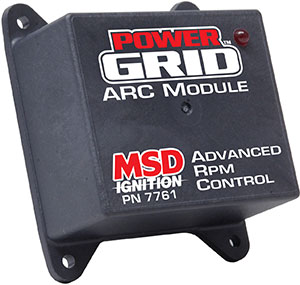
1 of MSD's latest systems featuring traction command capabilities, the PowerGrid and ARC Module uses a driveshaft curve rather than an engine RPM curve with an eight-signal magnet driveshaft sensor that apace reacts to changes in driveshaft speed (tire spin). The ARC Module features three curves (A, B, and LIMIT), that pulls engine timing based on a pre-set A and B driveshaft bend. The LIMIT curve acts as a difficult RPM rev limiter one time the spin develops beyond the B curve. Substantially, the ARC Module address tires pin with timing, more timing, and finally, an RPM limiter.
Bong: Evidently the less feel that yous take, the more beneficial that traction control is going to be. It allows you lot to become up and down the race track, and that builds a library of data that will help the racer to better empathise what it takes to make clean passes. A tuner that'due south been doing this for years or even decades that has a lot of data to tune from will know where the edge is and what it takes to get up and down the race track.
DZ: From filibuster boxes to Bump Boxes to air shifters, drag racers have many "aids" they didn't have 25 years ago. In essence, traction control is actually just an assist, and then why is it nonetheless existence shied away from?
Davis: Mainly, the series just don't sympathise it. They retrieve you can bolt the box into the car and information technology will take all of the tuning out of it. But it doesn't — it's only ane more tool that a racer has in their arsenal. It's just similar a delay box, in that only considering you have it, information technology doesn't hateful y'all're going to win. You have to learn how to use information technology too. Smart tuners like Steve Lilliputian and others learn how to utilize the tools that are in that car, and through that knowledge, they can and then employ them to their advantage.
Pando: Using Pro Stock equally an example, the racing is already so tight without the employ of traction control, that the serial doesn't encounter a demand for it. If there was a wide disparity betwixt the cars and one racer was dominating, they would probably take a closer look at why it is that way.
Bell: People volition e'er blame what they don't understand, and more often than not, it's e'er the racing series and sanctioning bodies that are the last to desire to sympathize the applied science. It's this black magic that a lot of people don't desire to impact. It just has this stigma.
The racing series don't see whatever reason to muddy the waters, and then to speak, only it would be interesting to see what it would do for the racing on some of the marginal tracks.
Capps: We've not instituted the utilize of traction control in our serial for a couple of reasons. The first is the price. If i racer has information technology, so every racer in the class has to accept it to stay competitive, and that simply raises the cost to go racing. Secondly, it's a very hard thing to police. Nosotros have to go in there and see what the racer is doing with it and how they're tying it into all of the various systems of the vehicle. It's possible that we may let its utilise in the future in some of our heads-upward classes to create better side-by-side racing, but at this time, we don't take whatever plans for it.
D 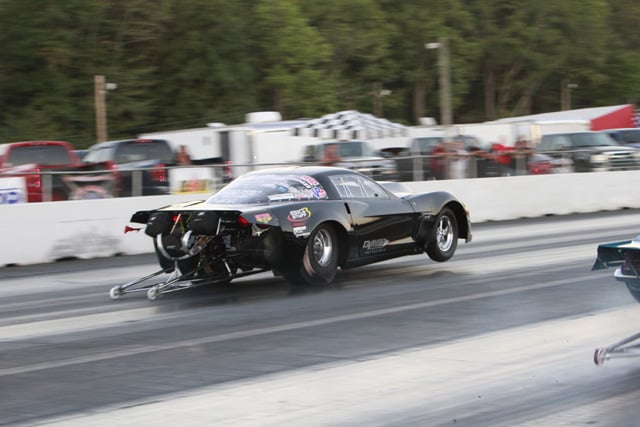 Z: Would you consider traction command a prophylactic feature?
Z: Would you consider traction command a prophylactic feature?
Capps: I wouldn't go and so far as to say it'southward a safety item, because y'all still take to have a drivers that's cognizant of their own vehicle. Honestly, traction control isn't anymore of a safety particular than a wheelie bar or an air shifter is.
Bell: We haven't looked at it as a safety item, but we accept seen runs where racers accept gotten in their own oil and it's pulled timing out to help stabilize the car, but it's still the responsibility of the driver to take over command. I wouldn't want to say that information technology's not a prophylactic particular, but I wouldn't want to rely on information technology either.
Pando: You lot could look at traction control as a condom item. If an inexperienced driver is making the move to a faster grade, it would definitely assist in their transition.
Davis: I don't like to say it, but manifestly if y'all're not spinning the tires, you lot accept more command of the car, and when you have more control of the automobile, it'southward safer. Nosotros won't try to sell traction control every bit a condom device, and it'south not going to go on you from crashing, but it helps.

Davis Technologies' TMS-Drag Pro 2 is a high-end unit of measurement that's fully cocky-learning, with adjusable starting line and ending RPM as well equally the null zone, and is capable of reacting inside ane/8 of a turn of the driveshaft.
Both Frankie and Joey Martin ran into situations where they got into their ain oil and saved the car through a lot of good luck and not bad driving. When we looked at the data on the calculator, the traction control was on and it was on hard, and before you meet the driver make any reaction to the situation, the traction control is already on. In fact, Joey told me that he felt the motor lay over before he even realized that it was in the oil and spinning the tires.
DZ: How do your technical departments keep traction control out of the cars? What methods are they employing?
Bong: We await for the tell-tale signs, such every bit actress sensors and magnets on the driveshaft, and we'll pull Racepak data from the cars and analyze information technology. Nosotros'll also pull ignition data from some of the cars to study. Nosotros have several devices that we can use to check for it, but we'd rather not go into also much item on that.
Wherever a racer is going to hide it, information technology can be establish. It's just a matter of looking deep plenty. – Trey Capps

Nosotros more often than not choice a few cars for a spot-cheque at the scales at every outcome, and normally that gets everybody talking.
Capps: We practise perform regular spot checks on the cars by inspecting the wires and the data on the computers and laptops. Regardless of where a racer is going to hibernate it, it can be plant. It'south just a matter of looking deep enough.
Pando: We work closely with the NHRA, and they were on board with us when we developed our traction command systems. To ensure them the comfort level that they have, we built tools for them that volition go in and detect traces of traction command, whether or non it's beingness used, and provide a footprint to encounter how long ago it was in that location. With these tools that we supply to them at their disposal, they in plow are accepting of the states developing products with engineering designed for non-NHRA classes that won't migrate into their playground, and if they practice, they've got tools to look for information technology and keep the racers honest and the playing field level.
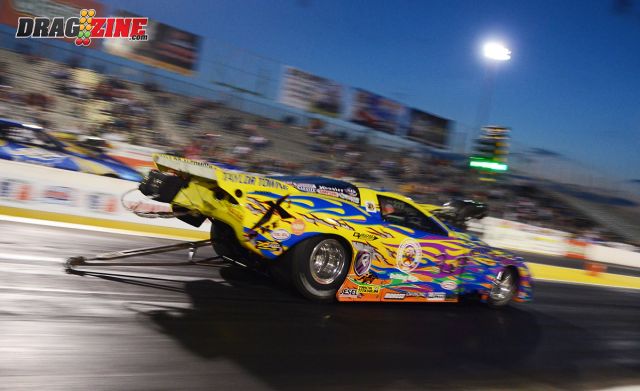 We provide these tools for any sanctioning body that wants to use them, and nosotros have them in Commonwealth of australia, the NHRA, IHRA, and the ADRL. In essence it'southward a custom mitt-held unit that they plug into the Canbus that will sniff it out and return information about the use of traction control. These tools tin also deliver a fourth dimension postage stamp that will inform officials when the feature was last used. Teams are immune to examination with information technology, so every bit long as the time indicates that it hasn't been used during the event, that's acceptable. The sanctioning bodies only don't want the racers racing with it.
We provide these tools for any sanctioning body that wants to use them, and nosotros have them in Commonwealth of australia, the NHRA, IHRA, and the ADRL. In essence it'southward a custom mitt-held unit that they plug into the Canbus that will sniff it out and return information about the use of traction control. These tools tin also deliver a fourth dimension postage stamp that will inform officials when the feature was last used. Teams are immune to examination with information technology, so every bit long as the time indicates that it hasn't been used during the event, that's acceptable. The sanctioning bodies only don't want the racers racing with it.
DZ: What does the future of traction command expect like? Are these systems as advanced as they can be, or is this merely the tip of the iceberg?
Pando: It'due south amazing to think what we're doing today with but a unmarried sensor. If you really want to get after it, information technology'southward all based on toll. The systems that we have bachelor today tin can exercise near of the functions of high-end systems, and our goal is to continue the price down for the racer.
Davis: Traction control systems in the future will be faster, much more than tunable in terms of how much timing is taken out and at what signal on the race rails, and they'll exist mappable, where you tin can gear up a target driveshaft speed that you lot want to run and it will agree true to that.
We don't desire to let the cat out of the pocketbook too much, but we have some things in the works for the about future.
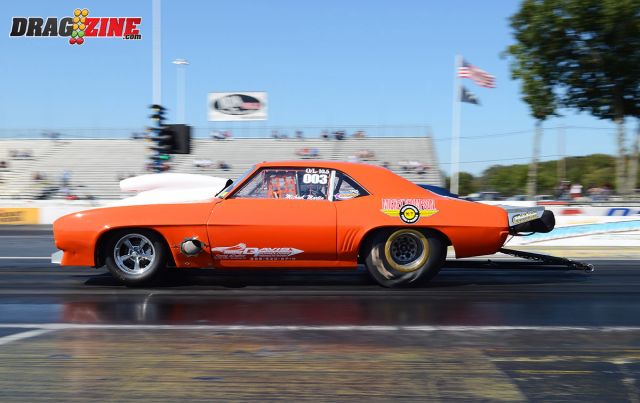
DZ: Do yous envision traction command eventually becoming legal in many or all sanctions of drag racing?
Davis: I can't speak to them, but they may come effectually at some indicate and realize that information technology's not a crew chief in a box. It may produce amend racing, and it's safer, and so why not?
Pando: I work closely with a lot of the sanctioning bodies, and many of them have classes that they merely won't allow the use of traction control because they don't feel that there is a need for information technology, so information technology's hard to say what the future holds for the engineering.
In Closing…
Few technologies one time considered controversial and unspoken of have gained credence equally swiftly as traction control in elevate racing, and innovators and trailblazers like those in our guest console are to thank for that. There's no question that the applied science and information technology'due south achieve has influenced the sport, and whether that influence has been positive or negative is a matter of personal stance, but information technology's safe to say the applied science is here to stay.
Source: https://www.dragzine.com/features/interviews/qa-how-traction-control-is-changing-drag-racing/
0 Response to "How Does a Funny Car Keep Tire Traction"
Post a Comment